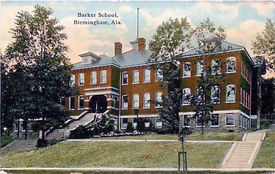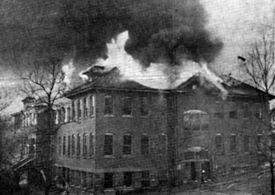Barker Elementary School: Difference between revisions
No edit summary |
No edit summary |
||
| Line 16: | Line 16: | ||
'''Barker Elementary School''' was a [[Birmingham City Schools|Birmingham school]] located on the corner of [[13th Avenue North|13th Avenue]] and [[23rd Street North]] in [[Druid Hills]]. | '''Barker Elementary School''' was a [[Birmingham City Schools|Birmingham school]] located on the corner of [[13th Avenue North|13th Avenue]] and [[23rd Street North]] in [[Druid Hills]]. | ||
The central portion of Barker School was built in [[1904]] | The central portion of Barker School was built in [[1904]]. It was named for civil engineer [[William Barker]], who laid out [[Birmingham]]'s [[Birmingham city center street grid|city center street grid]] and resided in the area for three decades before his death in [[1899]]. | ||
Two wings were added to the school in [[1910]]. By [[1923]] the school, with 16 classrooms of varying size, had an enrollment of 972 students in grades 1 through 7 and was judged to be "overcrowded" in the Board's survey of that year. | Two wings were added to the school in [[1910]]. By [[1923]] the school, with 16 classrooms of varying size, had an enrollment of 972 students in grades 1 through 7 and was judged to be "overcrowded" in the Board's survey of that year. | ||
Revision as of 15:06, 10 March 2021
| Barker Elementary School | |

| |
| Active | 1904–1941 |
|---|---|
| School type | Public |
| District | Birmingham City Schools |
| Grades | 1-7 |
| Colors | |
| Mascot | |
| Location | 1300 23rd Street North, (map) Birmingham |
Barker Elementary School was a Birmingham school located on the corner of 13th Avenue and 23rd Street North in Druid Hills.
The central portion of Barker School was built in 1904. It was named for civil engineer William Barker, who laid out Birmingham's city center street grid and resided in the area for three decades before his death in 1899.
Two wings were added to the school in 1910. By 1923 the school, with 16 classrooms of varying size, had an enrollment of 972 students in grades 1 through 7 and was judged to be "overcrowded" in the Board's survey of that year.
The school was destroyed by a fire which started in the boiler room during the early morning of March 14, 1941. The fire was discovered by Ralph Blue, a Birmingham Age-Herald paper carrier who noticed flames at 5:10 AM while working his route. Companies from Fire Station No. 1, No. 4, No. 5, No. 9, No. 11, No. 22 responded to the alarm, which Chief Alf Brown described as 'one of the meanest fires we've had in a long time." The flames, fueled by pine-framed walls was conducted from the boiler room to the roof through heat transfer ducts. The firefighters' efforts were hampered by the steep hilltop site.

At the time of the fire, 527 students were enrolled in the school. They were transferred to Seventeenth Avenue, Norwood, Martin and Powell Schools. Henley School PTA president Harry Singler labelled the older Henley and Powell Schools as "firetraps" like Barker, and suggested that the board tear them down and replace all three with a single, modern combined school in a central location, presumably downtown near the existing Powell School site. Some parents of children that attended Barker resisted the idea of sharing a new school with children from the newly-opened Central City Housing Project, expressing concern over the risk of students having to cross the railroad tracks on 10th Avenue North. Ultimately, the insurance settlement was used to build a new 8-room addition to the Seventeenth Avenue School. The damaged building was demolished and the cleared site became Barker Park.
Principals
- George E. Wallace, 1903–1910
- R. C. Johnston, 1923
- Theo Wright, 1926–1941
References
- Cruikshank, George H. (1920) History of Birmingham and Its Environs: A Narrative Account of Their Historical Progress, Their People, and Their Principal Interests 2 volumes. Chicago, Illinois: Lewis Publishing Company. - via Birmingham Public Library Digital Collections
- Birmingham Board of Education (1923) The Birmingham School Survey.
- "Early Morning Blaze Destroys Old Barker School" (March 14, 1941) The Birmingham News - via Birmingham Public Library Digital Collections
- Kelly, Betty (March 14, 1941) "Barker Pupils Deeply Moved" The Birmingham News - via Birmingham Public Library Digital Collections
- "Barker Classes To Continue" (March 15, 1941) Birmingham Age-Herald - via Birmingham Public Library Digital Collections
- "Parents Reject School Combine" (March 25, 1941) Birmingham Age-Herald - via Birmingham Public Library Digital Collections